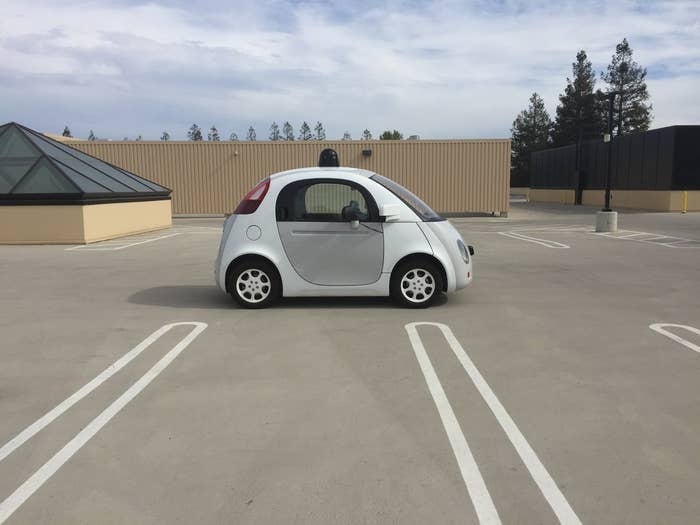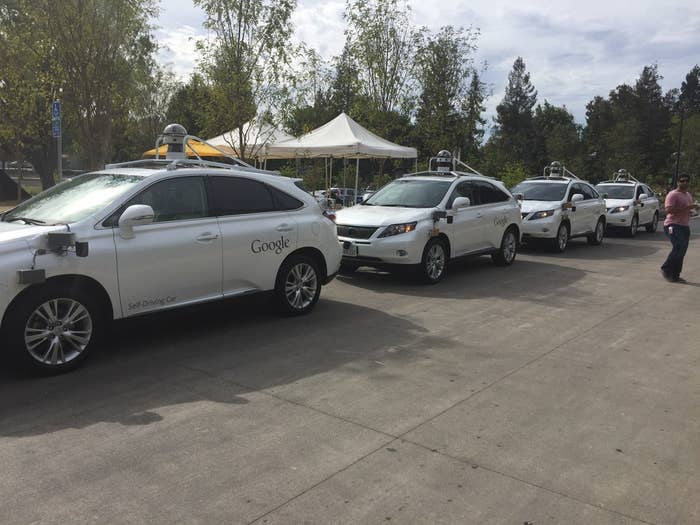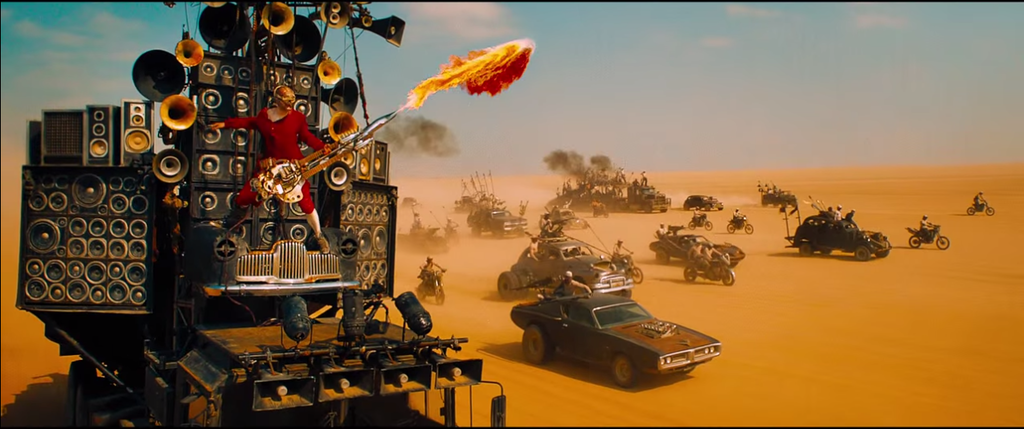
The thing about covering tech, especially for a long time, is that you have these moments where you get to really reach out and touch the future. They're rare. But you get to the point where you can recognize them and see the truly significant shifts.
The very early web felt that way. So did the first iPhone. It was the way I felt the first time I put an Oculus Rift on my face, in a Las Vegas hotel room in 2013. Strap it on and, whoa. That's what getting in a fully autonomous self-driving car is like, too.
There's a lot of skepticism about self-driving cars. About how successful they'll be, about whether people will really want to use them, about whether they're safe. But this is what you should know about autonomous vehicles: They are coming. Inevitably. Inexorably. Coming.
On Tuesday, I — along with a lot of other journalists — rode in Google's prototype car. It's a little round clown car looking thing that Google built from the ground up. It's adorable — and, oddly, less weird-looking than the company's fleet of Lexuses, whose cars have cameras and lasers and radar sensors bolted all over the body. (One also suspects that the cars look intentionally nonthreatening. That they very much are not intended to look like some of Google's other robots.)

But part of the reason it looks like it does is precisely because Google did build it — or more precisely, have it built — from the ground up. Google had a chance to rethink the way a car could be configured if it were never going to be driven by a human being, and so Google's little prototypes look nothing like a normal car on the inside. You get in, put on a seatbelt, and sit next to a fellow passenger on a bench seat, but that's about it. To start the car, you push a button between the two of you and it just…goes. There's no steering wheel. No gas or brake pedals. There's not really even a proper dashboard: Just a display. It's roomy and cozy and feels a bit like riding in a gondola.
Google sent reporters around a rooftop parking lot full of obstacles. A man walked out in front of the car. A bicyclist merged in front of us and unexpectedly took a left. It slowed, it stopped, it turned corners. It was *fun*.
The New York Times reporter who sat next to me compared it to a haunted house ride at an amusement park, and it's true: The ride did feel scripted. Look, a ghost! A bicyclist! It would have been preferable to get a sense of the car on the open road. But even in the four minutes we zipped around the lot, you could get a real feel for what the experience is like. It is, in a word, relaxing. It's pleasant. Get some reading done. Sit back. Have a drink. Enjoy the ride. Have another drink. The car's got it.

Yet this kicked-back experience is a single sentence in the longer story of why autonomous cars are better.
The first time I rode in a fully autonomous car, what really impressed me was when the car saw something that I could not. As I rode down a residential street in Mountain View, the car slowed, for no apparent reason. Yet in the front seat, a laptop showed everything the car could "see." And up ahead, there was a man, in the street, standing behind a double-parked vehicle. He was concealed from my eyes, but the car detected him. And it slowed down, anticipating that he might step out unexpectedly.
It anticipated this because each and every one of Google robot cars has experienced the totality of everything all its siblings have experienced. Google's cars have driven a total of 1.2 million miles on the roads. We tend to think of this as combined experience — an aggregate number. But what it really means, effectively, is that every single car has driven that distance, has experienced it. This is a machine that learns. And in addition to that on road time, the cars log, Google said yesterday, 3 million miles every day running scenarios.
This car is a better driver than me, or you, or any of us.
But like anything new, people are concerned about it. And so, a scowling, red-faced reporter from Australia, after explaining how much Australians love their cars (we know), bellowed at a Crocs-clad Sergey Brin: "How dare you mess with that relationship between the car lover and their car? And is the goal here a future without human drivers?"
People should, very much, be concerned. There are a lot of questions we should be asking about self-driving cars (Will they be privately or publicly owned? Both? Will nonautonomous vehicles be banned? When? How will we secure them from hacking and viruses and malware and plain old-fashioned bugs? How can we preserve our location privacy? How will they operate in disaster and evacuation scenarios? How will they be insured? And purely in terms of Google, if it isn't getting into the manufacturing business, and given that it doesn't operate purely altruistically, how does it intend to turn a profit off of this highly expensive research project it has embarked on? What will it track? What will it monitor? What will it do inside those cute little cars?), because autonomous vehicles will become a pervasive technology and we should always interrogate things that will transform our society before, rather than after, the fact.
But these two questions were both really dumb.
Cars are giant, inefficient, planet-and-people-killing death machines. Self-driving cars — especially if they are operated as fleets and you only use one when you need it, summoning it Uber-style — would mean we could have fewer vehicles per person, less traffic congestion, less pollution, far fewer vehicles produced per year (thus lowering the environmental impact of production), and, best of all, safer streets. The blind, people with epilepsy, quadriplegics, and all manner of others who today have difficulty ferrying themselves around as they go through the mundanities of an average day will be liberated. Eliminating the automobile's need for a human pilot will be a positive thing for society.
So go fuck a tailpipe if you love cars so much. Your love for cars doesn't supersede the lives of 1.2 million people who die in automobile accidents every year. It's not more important than the energy savings we'll get from not manufacturing 60 million or so vehicles every year that spend most of their time idle. Turned off. Parked.
New technology comes at us so quickly now, and with so much hype that it's reasonable to wonder if it's real and truly transformative. (Consider Google Glass or the Segway.) So this is what you should know about the technology behind self-driving, fully autonomous vehicles: It's real. It's transformative. It's coming.
A future without human drivers is a long, long way off. But we'll get there. No matter what you think. No matter what you hope. No matter how you feel about it. Because the efficient, unemotional, necessary logic of cars that operate without human error and instability is unquestionable.
But when a little self-driving car does, at last, pull up at your door, whether it's a Google car or an Uber car or an Apple car or a Ford, hopefully we'll have asked the right questions of it before it gets there. Hopefully we'll have properly interrogated it.
Because when you do get in, you're going to be delighted, and you're going to want to ride it again and again. There's no stopping them.
CORRECTION
Ugh. I first tried Oculus at CES in 2013, not 2012 as an earlier version of this story stated. Vegas, man.
